

Read about PASS/START-PROF pipe stress analysis software
Above ground pipelines experience inertial forces from seismic basement accelerations. See here for calculation methodology.
For buried pipelines, inertial forces are negligible due to soil damping. Stress analysis focuses on soil deformations from seismic wave propagation.
Photos below show seismic wave effects:

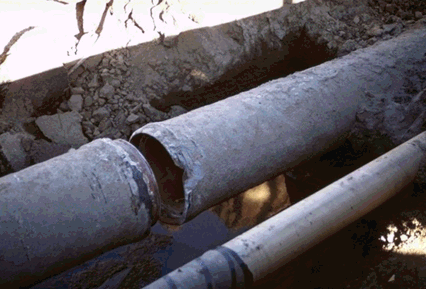
Longitudinal (P-) waves cause axial pipe deformation as soil particles move parallel to wave direction.
Shear (S-) waves cause bending deformation as particles move perpendicular to wave direction.
Rayleigh waves create complex surface motions similar to water waves, causing significant bending deformation.

Ground point movements during P-waves, S-waves, Love waves, and Rayleigh waves
Longitudinal waves along pipe axis cause axial deformation:

where Vmax is maximum horizontal ground velocity, Vp is longitudinal wave velocity.
Shear waves along pipe axis cause bending:

where Amax is maximum ground acceleration, Vs is shear wave velocity.
Rayleigh waves cause combined bending and longitudinal deformation:

Shear waves at angles to pipe axis cause longitudinal deformation:

Maximum deformation occurs at 45 degrees:

Deformation formulas for various wave angles:

PASS/START-PROF analyzes piping systems with surrounding soil, applying seismic wave deformations. Stresses depend on geometry, restraints, and soil properties.
Pipes follow soil movements until pipe-soil friction limits are exceeded. Diagram shows soil movements during P-wave passage and friction force directions:
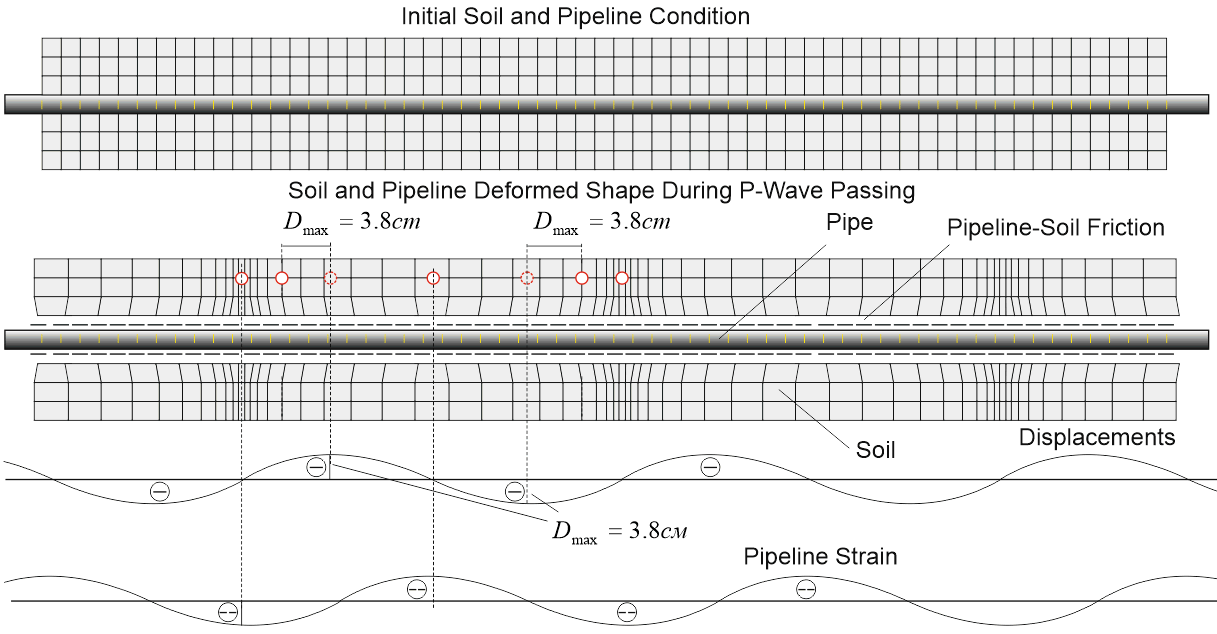
Axial stress distribution from P-wave propagation:
a) Soil point movement along pipe
b) Soil deformation function
c) Axial stresses with no pipe-soil slippage (infinite friction)
d) Axial stresses with high friction and long wavelength
Pipe restraint zones occur where slippage is prevented, typical in rocky soils.
e) Axial stresses with full-length slippage. Maximum stresses depend on friction and wavelength, common in most cases.

Highest stresses occur at restraints preventing pipe-soil movement: bends, branches, anchors. Stresses near these points approach no-slippage values:

Reduce stresses and branch loads with design solutions like excavation wells at branches or flexible expansion joints.
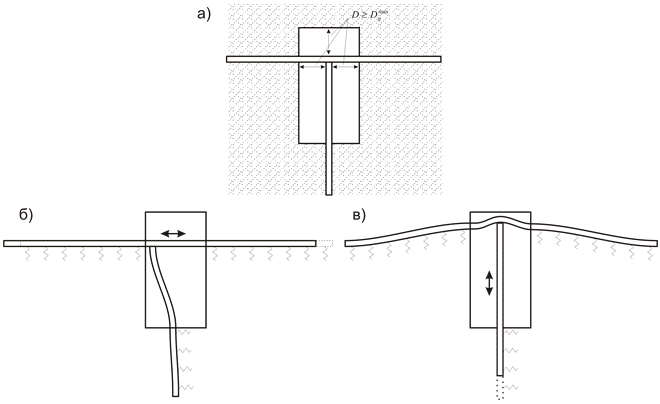

Applicable codes for seismic wave propagation analysis:
ASCE 2001 Guidelines for the Design of Buried Steel Pipe (ALA)
GB 50032 (China)
GB 50470 (China)
SNiP 2.05.06-85 (Russia)
SP 36.13330.2012 (Russia)
GOST R 55989-2014 (Russia)
GOST R 55990-2014 (Russia)
SP 284.1325800.2016 (Russia)
SP 33.13330.2012 (Russia)
PASS/START-PROF uses "equivalent thermal expansion" method for arbitrary pipeline configurations.
Calculate equivalent pipeline strain using improved method based on [9] and other research [1]-[8]. This strain applies as additional thermal expansion. Method includes all three seismic wave types (P, S, R) instead of only P-wave in original ASCE 2001.

If only peak ground acceleration data available, use this table (per ASCE 2001):

Recommended wave velocities [12]:
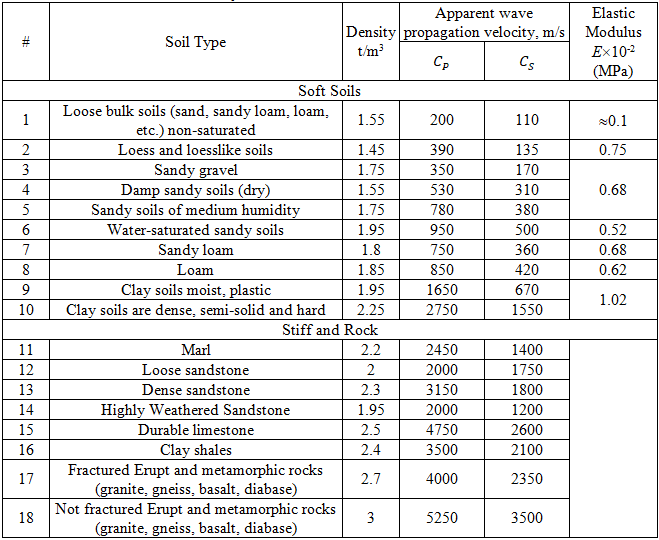
Specify apparent wave propagation speed based on soil layer properties, not surface soil only. Calculate using layer thicknesses and wave speeds:
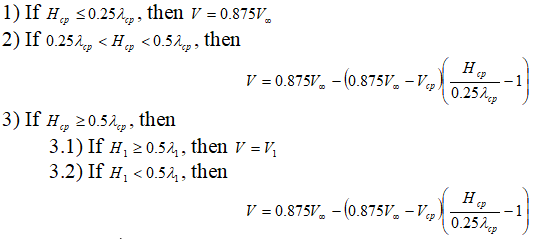


For long straight restrained pipes between anchors, calculated stresses match equations above. Complex configurations with bends, branches, and expansion loops reduce longitudinal stresses but add bending stresses. Use PASS/START-PROF to optimize expansion loop spacing for seismic stress reduction.
Enable seismic wave analysis in Project Settings. Set Sa calculation parameters in pipe properties. Check results in stress table after analysis.
Two checks performed:
First check per ASCE 2001 (ALA):
Stresses from thermal expansion, weight, and seismic waves. For straight pipes only. Allows 0.5% tensile strain; compression checks for buckling.

Second check:
Stresses from thermal expansion, weight, and seismic waves. For straight pipes and fittings. Based on 4× yield stress limit (approximately 0.4% strain).

F - Axial force from thermal expansion, pressure Bourdon effect, weight, and seismic waves
E - Elastic modulus
t - Pipe wall thickness
D - Pipe outside diameter
Sy - Yield stress at operating temperature
Sh - Allowable stress at operating temperature
Model landslides, permanent ground deformation (seismic faults), or other soil movements by adding soil movements in buried pipe properties. Learn more.
1. ASCE 2001 Guidelines for the Design of Buried Steel Pipe (American Lifelines Alliance), 11.1
2. ASCE 4-98 Seismic Analysis of Safety-Related Nuclear Structures and Commentary, 3.5.2
3. ASCE Guidelines for the seismic design of oil and gas pipeline systems, ch.6
4. ASCE Structural Design and Analysis of Nuclear Plant Facilities, 7.6.2
5. BNL-52361 Seismic design and evaluation guidelines for the department of energy high-level waste storage tanks and appurtenances, 1995, ch. 7
6. American Lifelines Alliance Seismic guidelines for water pipelines, 2005
7. M.J. O'Rourke, X. Liu Response of buried pipelines subject to earthquake effects, 1999
8. Savinov O.A. Seismic resistance of main pipelines and special structures of oil and gas industry, 1980
9. Birbraer A.N. Calculation of structures for seismic resistance, 1998
10. SNiP 2.05.06-85
11. GB 50032
12. Methodological recommendations for determining dynamic properties of soils, rocks and local building materials. P01-72. // VNIIG, 1972